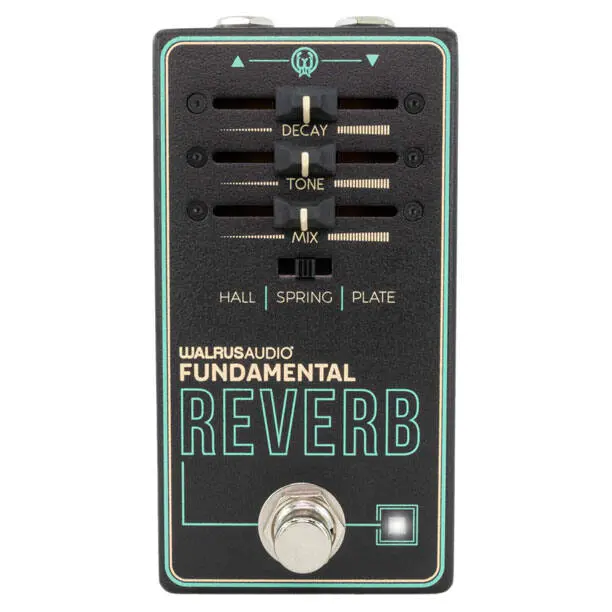
The Walrus Audio Fundamental Reverb encapsulates the Oklahoma-based company’s experience in designing top-notch reverb effects in a super-affordable, 3-mode compact stompbox – the first they ever released with a sub-$200 price tag.
The three available modes, accessible via the slider switch located in the center of the pedal, were carefully selected to arm the guitarist with the most popular and useful types of reverb for guitar:
- Hall is the most “ambient” of the options, with long decay times conveying the reflections heard in a large empty room.
- Spring is the shortest reverb on the menu, and delivers the classic vintage effect found in tube amps from the ’60s, with their bouncy and “drippy” character.
- Plate emulates the sound of vintage studio units based on the old plate technology, producing a denser, smoother and more focused. reverberation
The bread and butter controls, stylishly assigned to faders rather than knobs, allow setting Decay (i.e. reverb length), Tone and Mix, while holding down the bypass stomp switch when applying power to the pedal will activate Trail mode.
Here are the videos!
Walrus Audio Fundamental Reverb, Builder’s Notes
For the Fundamental Series, we challenged ourselves to design a set of pedals with the tonal integrity that’s required to live on a professional’s pedalboard, but with simplified controls friendly enough for even the newest effect pedal users. Each Fundamental pedal has three faders for tweaking the sound and a three-way switch for changing pedal modes. The result is a line of pedals that will keep you covered from your first band practice all the way to a sold-out arena. Designed and assembled at Walrus Audio headquarters in OKC, OK.
The Fundamental Reverb provides you with the core sounds of ambient effects. With three reverb algorithms, you can go from an ambient hall to an analog spring emulation, as well as a bright plate emulation.
Decay: Control the amount of reverb decay time. Left is the minimum and right is the maximum amount of time.
Tone: Control the amount of overall brightness to the reverb
Mix: Control the mix of the effect and the original clean signal. All the way to the left outputs only the fully clean signal, and all the way to the right outputs only the affected Reverb signal.
Slide Switch – The slide switch allows you to change between three distinct Reverb algorithms.
Hall – Emulates the large sounds of an acoustic hall, characterized by long decay times and a more diffused and spacious sound.
Spring – Emulates the bouncy twang of the spring reverb commonly found in tube amps.
Plate – Emulates a smooth analog plate reverb, offering a denser, more focused reverberation of the signal.Trails Modes – The Reverb comes with trails mode active by default, to disengage trails mode hold down the bypass stomp switch when applying power to the pedal. Once the LED flashes it indicates that trails mode is turned off. To re-engage trails mode, repeat the process, and wait for the LED to turn dark, indicating that trails mode is back on. With trails mode active, your reverb decay will fade off naturally after turning the pedal off. With trails mode inactive, the decay abruptly cuts off when you turn off the pedal.






















